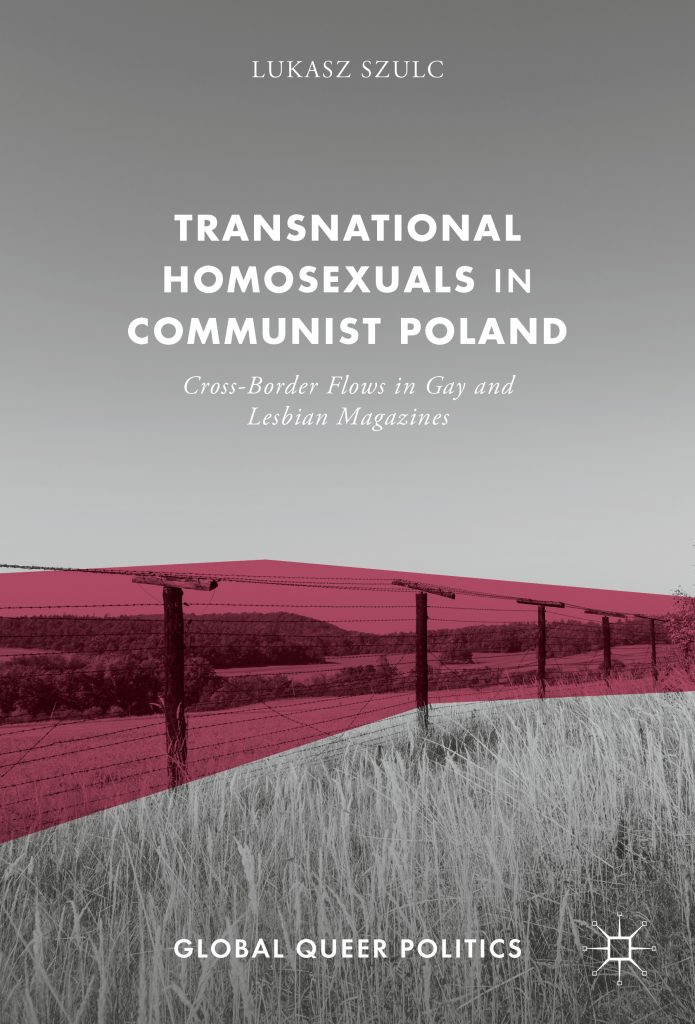Interview by Karl Thomas
Transnational Homosexuals in Communist Poland traces the history of the first Polish gay and lesbian magazines to explore the globalization of LGBT identities and politics in Central and Eastern Europe during the twilight years of the Cold War. It details the emergence of a homosexual movement and charts cross-border flows of cultural products, identity paradigms and activism models in communist Poland. The work demonstrates that Polish homosexual activists were not locked behind the Iron Curtain, but actively participated in the transnational construction of homosexuality. Their magazines were largely influenced by Western magazines: they used similar words, discussed similar topics or simply translated Western texts and reproduced Western images. However, the imported ideas were not just copied but selectively adopted as well as strategically and creatively adapted in the Polish magazines so that their authors could construct their own unique identities and build their own original politics.

Karl Thomas: Why were DIY magazines important to the LGBTQ community in Poland and when did you discover this importance in you research?
Lukasz Szulc: The magazines started as a kind of ‘hobby horse’ project. The first magazine Etap was first produced in 1983 by Andrzej Selerowicz in Vienna as a one-page newsletter, which he then brought to Poland. The second magazine Filo started in a similar way: a one-man project by Ryszard Kisiel who was very interested in journalism and just wanted to create something for his close friends. There were only 30 copies at the very beginning, reaching 1000 copies at its height.
The magazines played an important role for the development of the LGBTQ movement because informal groups started forming around them. Selerowicz, for example, contacted people in Wrocław to help him distribute the magazine and out of that a group formed which took the same name as the magazine — Etap. At one point this group enquired about the possibility of being officially registered by the Polish authorities but was told this would not be allowed. From this we can see how the DIY magazines started as one-man projects and spread to encapsulate a feeling of solidarity among gay men and, to a lesser extent, lesbians.
At the beginning their content mainly focused on cultural information, for example books by Oscar Wilde, but later the magazines started to discuss activism too. They addressed key issues: What are our goals? Shall we work towards greater visibility in society at large? What about HIV and AIDS? Shall we collaborate with the Communist government?
Thus, early gay and lesbian activism in Poland formed around the publication of magazines. It was not the case that groups started to publish magazines but the other way around. The magazines served as a very specific medium around which gay men and lesbians gathered and built a community. Some commentators argue that gay and lesbian activism in Poland did not emerge until after the fall of Communism, but the groundwork was in place already in the 1980s through and around those magazines.
Thomas: When we think about evangelical Christianity we generally associate it with conservative attitudes to homosexuality. But in your book, you mention that in East Germany the church acted as an ally. How did this alliance come about?
Szulc: Different gay and lesbian groups in different socialist countries aligned themselves with different aspects of society, for example collaborating with sexologists in Czechoslovakia, student groups in Slovenia and church groups in East Germany, which I uncovered in reports of the Eastern Europe Information Pool (EEIP) created for the International Lesbian and Gay Association (ILGA). These are available on the book’s website: www.transnationalhomosexuals.pl. One report mentions that some of the East German activists belonged to the church. They needed a space where they could meet and the church agreed. We can see that this alliance influenced their agenda which included, for example, discussions of homosexuality in relation to religion. We can contrast this with gay and lesbian groups from Slovenia, which were meeting in the Student Cultural Centre at the University of Ljubljana and focused on cultural events such as film screenings, poetry evenings and book exhibitions. These alliances were usually accidental.
Thomas: Apart from DIY magazines could you say more about the mainstream media’s coverage of homosexuality in Poland and how this informed the content of the magazines?
Szulc: Over the decades of state socialism in Poland the mainstream media changed their portrayal of homosexuality. At the very beginning, starting in the interwar period, homosexual men and women were mostly presented in a stereotypical way, generally associated with criminality or subject to ridicule. However, in later years this began to change slightly. The first sympathetic article I was able to find in the mainstream press was from 1974 and was published in Życie Literackie [Literary Life]. This article suggested that homosexuality was transhistorical, tracing it to Ancient Greece, and that homosexuals were a diverse group of people (among them there were both ‘gentlemen and scoundrels’, one could learn). More sympathetic coverage about homosexuality was published in the 1980s.
At the same time, the DIY magazines I analysed in the book were exclusively for internal communication; they were never meant to reach the mainstream. Nevertheless, authors of the magazines appeared in the media from time to time to speak about homosexuality — using pseudonyms and with their backs to the camera — and encouraged their readers to write letters to the editors of mainstream media to push back against stereotypical depictions of homosexuality.
Thomas: What was the impact of HIV/AIDS on activism and press coverage of homosexuality?
Szulc: HIV/AIDS was one of the key factors behind the growing visibility of homosexuality in the Polish mainstream media in the 1980s (other factors being the support from transnational organisations such as ILGA and socio-political changes in Poland). This is interesting because across the entire Eastern Bloc HIV/AIDS did not reach epidemic levels in the 1980s. It reached epidemic levels in some countries only after 1989, but in Poland it never really reached these levels. The first officially registered case of HIV in Poland was in 1985, much later than in the West. Nevertheless, the discussion about HIV and AIDS was prominent in the Polish media and it was linked to homosexuality, especially to homosexuals in the West. Because there was not much research done on the topic in Poland, journalistic information about HIV/AIDS relied on knowledge from the West. Articles were translated from such western publications as Newsweek and Der Spiegel. It was through this discussion of HIV/AIDS that western gay cultures were introduced in Poland.
It is also important to mention that gay and lesbian activists themselves used discourses of HIV and AIDS to explain why homosexual associations should be officially recognised in Poland. They argued that such associations were crucial for doing preventive work to reduce the spread of HIV in Polish society at large. One article in the mainstream media published by a self-identified homosexual man argued that official registration of a homosexual association would support homosexuals who were considered one of the main ‘risk groups’. The article continued that because homosexuals were often living under cover marriages at that time, it was only a matter of time before HIV/AIDS would also become a problem of the heterosexual part of the society.
Thomas: Could you describe the relationship between LGBT movement and the trade union Solidarity?
Szulc: At first, Solidarity was neutral on the topics related to gender and sexuality. But after the introduction of martial law in 1981 Solidarity had to go underground and relied on the infrastructure of the Catholic Church, holding their meetings in secret in church buildings for instance. This increased Catholic influence on the organisation and therefore it became more conservative, asking, for example, for tougher abortion provisions. Nevertheless, some authors argue that even though Solidarity became conservative in matters related to gender and sexuality, it still provided gay and lesbian groups in Poland with great inspiration.
Thomas: What was the attitude of the communist authorities in Poland in the 1980s towards homosexuals?
Szulc: Polish communist authorities did not take a clear stance on homosexuality and reacted to it differently, sometimes contradictorily, in different situations. Eastern Europe Information Pool reports mention, for example, that the introduction of martial law at the very beginning of the 1980s negatively affected homosexuals because of the general restrictions placed on the population. But a year later, another report stated that the police were so busy with political dissidents that they did not have time to focus on such a marginal topic as homosexuality, so there were, it seems, some opportunities for increased freedom for homosexuals. However, this was just mentioned in one of the EEIP reports so we should be careful about making generalizations based on this. Contradicting this was a common practice of the police forces to surveil homosexuals which culminated in the 1985 Operation Hyacinth, which I’ve written about previously at NOTCHES.
Thomas: And finally, what is your next project and how is informed by your work around the DIY magazines?
Szulc: I’m a media scholar and I usually work on digital media so this book was an unusual project for me. But now I’m back on track working again with digital media. I’m currently interviewing Polish LGBTQs in the UK about their migration stories, national and gender/sexual identities as well as their use of social media such as Facebook, Twitter and Instagram, but also dating sites. My historical research for the book helped me to take a fresh perspective on digital media and think about them in a broader historical context. For example, in my new research I plan to compare personal ads found in the 1980s magazines to contemporary dating sites profiles.
 Lukasz Szulc is a Lecturer in Digital Media and Society in the department of Sociological Studies at The University of Sheffield and Marie Curie Research Fellow in the department of Media and Communications at the LSE. He is also co-chair of LGBTQ Interest Group in International Communication Association. He is author of the book Transnational Homosexuals in Communist Poland: Cross-Border Flows in Gay and Lesbian Magazines (2018, Palgrave) and co-editor of the collection LGBTQs, Media and Culture in Europe (2017, Routledge). He has published articles in journals such as Sexualities, New Media & Society and Social Media + Society. His website is www.lukaszszulc.com and he tweets from @LukaszSzulc.
Lukasz Szulc is a Lecturer in Digital Media and Society in the department of Sociological Studies at The University of Sheffield and Marie Curie Research Fellow in the department of Media and Communications at the LSE. He is also co-chair of LGBTQ Interest Group in International Communication Association. He is author of the book Transnational Homosexuals in Communist Poland: Cross-Border Flows in Gay and Lesbian Magazines (2018, Palgrave) and co-editor of the collection LGBTQs, Media and Culture in Europe (2017, Routledge). He has published articles in journals such as Sexualities, New Media & Society and Social Media + Society. His website is www.lukaszszulc.com and he tweets from @LukaszSzulc.
 Karl Thomas is an MA student in Queer History at Goldsmiths, University of London. His academic interests include walking methodologies, London history, twentieth-century British working-class life as depicted in film, Central and Eastern Europe in the Communist era and Queer Theory. Karl is an active member of Goldsmiths Students Union and tweets from @MrBuddwing65
Karl Thomas is an MA student in Queer History at Goldsmiths, University of London. His academic interests include walking methodologies, London history, twentieth-century British working-class life as depicted in film, Central and Eastern Europe in the Communist era and Queer Theory. Karl is an active member of Goldsmiths Students Union and tweets from @MrBuddwing65

NOTCHES: (re)marks on the history of sexuality is licensed under a Creative Commons Attribution-NonCommercial-NoDerivatives 4.0 International License.
Based on a work at www.notchesblog.com.
For permission to publish any NOTCHES post in whole or in part please contact the editors at NotchesBlog@gmail.com




